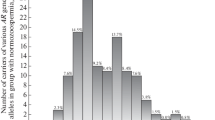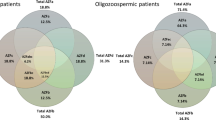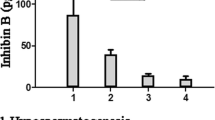Abstract
An analysis of the number of CAG repeats in exon 1 of the gene was conducted in a group of 228 infertile males with azoospermia (n = 68) and oligozoospermia (n = 160), and in a control group (124 proven fathers) by means of polymerase chain reaction with subsequent fragment analysis on an ALF-Express automated fluorescent analyzer. Allele frequency with the number of CAG repeats ≤ 18 was found to be significantly higher (P < 0.01) in the group of patients with azoospermia (17.7%) as compared to the control group (2.4%), and in the group of patients with oligozoospermia (12.5%) as compared to the control group (2.4%). Allele frequency with the number of CAG repeats ≥ 28 was shown to be significantly higher (P < 0.01) in patients with oligozoospermia (12.5%) as compared to the control group (2.4%). Our data suggest an association between the number of CAG repeats and impaired spermatogenesis in azoospermic and oligozoospermic males.
Similar content being viewed by others
References
Kochakian, C.D., Definition of Androgens and Protein of Anabolic Steroids, Pharmacol. Ther. [B], 1975, vol. 1, no. 2, pp. 149–177.
McLachlan, R.I., Wreford, N.G., O’donnll, L., et al., The Endocrine Regulation of Spermatogenesis: Independent Roles for Testosterone and FSH, J. Endocr., 1996, vol. 148, pp. 1–9.
Mimeault, M. and Batra, S.K., Recent Advances on Multiple Tumorigenic Cascades Involved in Prostatic Cancer Progression and Targeting Therapies, Carcinogenesis, 2006, vol. 27, no. 1, pp. 1–22.
Lubahn, D.B., Brown, T.R., Simental, J.A., et al., Sequence of the Intron/Exon Junction of the Coding Region of the Human Androgen Receptor Gene and Identification of a Point Mutation in a Family with Complete Androgen Insensitivity, Proc. Nat. Acad. Sci. USA, 1989, vol. 86, pp. 9534–9538.
Brown, C.J., Goss, S.J., Lubahn, D.B., et al., Androgen Receptor Locus on the Human X-Chromosome: Regional Localization to Xq11–12 and Description of a DNA Polymorphism, Am. J. Hum. Genet., 1989, vol. 44, pp. 264–269.
Quigley, C.A, in Testosterone: Action, Deficiency, Substitution, Nieschlag, E. and Behre, H.M., Eds., Heidelberg: Springer, 1998, pp. 33–106.
Gottieb, B., Lombroso, R., Beitel, L.K., and Trifiro, M.A., Molecular Pathology of the Androgen Receptor in Male (In) Fertility, RBM Online, 2005, vol. 10, no. 1, pp. 42–48.
Crocoll, A., Zhu, C.C., Cato, A.C., and Blum, M., Expression of Androgen Receptor MRNA during Mouse Embryogenesis, Mech. Dev., 1998, vol. 72, nos. 1/2, pp. 175–178.
Yuong, W.J. and Chang, C., Ontogeny and Autoregulation of Androgen Receptor MRNA Expression in the Nervous System, Endocrine, 1998, vol. 9, no. 1, pp. 79–88.
McAbee, M.D. and DonCarlos, L.L. Ontogeny of Region-Specific Sex Differences in Androgen Receptor Messenger Ribonucleic Acid, Endocrinology, 1998, vol. 139, pp. 1738–1745.
Lubahn, D.B., Joseph, D.R., Sullivan, P.M., et al., Cloning O Human Androgen Receptor Complementary DNA and Localization to the X-Chromosome, Science, 1988, vol. 240, pp. 327–330.
Gelmann, E.P., Molecular Biology of the Androgen Receptor, J. Clin. Oncol., 2002, vol. 20, no. 13, pp. 3001–3015.
Zitzmann, M., Brune, M., Kornmann, B., et al., The CAG Repeat Polymorphism in the Androgen Receptor Gene Affects Bone Density and Bone Metabolism in Healthy Males, Clin. Endocrinol., 2001, vol. 55, pp. 649–657.
Tut, T.G., Ghadessy, F., Trifiro, M.A., et al., Long Polyglutamine Tracts in the Androgen Receptor Are Associated with Reduced Transactivation, Defective Sperm Production and Male Infertility, J. Clin. End. Met., 1997, vol. 82, pp. 3777–3782.
Giovannucci, E., Stampfer, M.J., Krithivas, K., et al., The CAG Repeat within the Androgen Receptor Gene and Its Relationship to Prostate Cancer, Proc. Nat. Acad. Sci. USA, 1997, vol. 94, pp. 3320–3323.
Mifsud, A., Ramirez, S., and Yong, E.L., Androgen Receptor Gene CAG Trinucleotide Repeats in Anovulatory Infertility and Polycystic Ovaries, J. Clin. Endocr. Metab., 2000, vol. 85, pp. 3484–3488.
Lim, H.N., Chen, H., McBride, S., et al., Longer Polyglutamine Tracts in the Androgen Receptor Are Associated with Moderate to Severe Undermasculinized Genitalia in XY Males, Hum. Mol. Genet., 2000, vol. 9, no. 5, pp. 829–834.
Haiman, C.A., Brown, M., Hankinson, S.E., et al., The Androgen Receptor CAG Repeat Polymorphism and Risk of Breast Cancer in the Nurses’ Health Study, Cancer Res., 2002, vol. 62, no. 4, pp. 1045–1049.
La Spada, A.R., Wilson, E.M., Lubahn, D.B., et al., Androgen Receptor Gene Mutations in X-Linked Spinal and Bulbar Muscular Atrophy, Nature, 1991, vol. 352, no. 6330, pp. 77–79.
Mitas, M., Trinucleotide Repeats Associated with Human Disease, Nucleic Acids Res., 1997, vol. 25, pp. 2245–2254.
Lund, A., Juvonen, V., Lähdetie, J., et al., A Novel Sequence Variation in the Transactivation Regulating Domain of the Androgen Receptor in Two Infertile Finnish Men, Fertil. Steril., 2003, vol. 79, pp. 1947–1948.
Maniatis, T., Fritsch, E.E., and Sambrook, J., Molecular Cloning. A Laboratory Manual, Cold Spring Harbor: Cold Spring Harbor Laboratory Press, 1982.
Agresti, A., A Survey of Exact Inference for Contegency Tables, Statit. Sci., 1992, vol. 7, pp. 131–153.
Schoenberg, M.P., Hakimi, J.M., Wang, S., et al., Microsatellite Mutation (CaG24 18) in the Androgen Receptor Gene in Human Prostate Cancer, Biochem. Biophys. Res. Commun., 1994, vol. 198, no. 1, pp. 74–80.
Irvine, R.A., Yu, M.C., Ross, R.K., and Coetzee, G.A., The CAG and GGC Microsatellites of the Androgen Receptor Gene Are in Linkage Disequilibrium in Men with Prostate Cancer, Cancer Res., 1995, vol. 55, pp. 1937–1940.
Komori, S., Kasumi, H., Kanazawa, R., et al., CAG Repeat Length in the Androgen Receptor Gene of Infertile Japanese Males with Oligozoospermia, Mol. Hum. Reprod., 1999, vol. 5, pp. 14–16.
Yong, E.L., Ghadessy, F., Wang, Q., et al., Androgen Receptor Transactivation Domain and Control of Spermatogenesis, J. Reprod. Fertil., 1998, vol. 3, pp. 141–144.
Author information
Authors and Affiliations
Additional information
Original Russian Text © O.A. Fesai, S.A. Kravchenko, M.Ya. Tyrkus, G.V. Makuh, V.M. Zinchenko, G.V. Strelko, L.A. Livshits, 2009, published in Tsitologiya i Genetika, 2009, Vol. 43, No. 6, pp. 45–51.
About this article
Cite this article
Fesai, O.A., Kravchenko, S.A., Tyrkus, M.Y. et al. CAG polymorphism of the androgen receptor gene in azoospermic and oligozoospermic men from Ukraine. Cytol. Genet. 43, 401–405 (2009). https://doi.org/10.3103/S0095452709060061
Received:
Published:
Issue Date:
DOI: https://doi.org/10.3103/S0095452709060061




